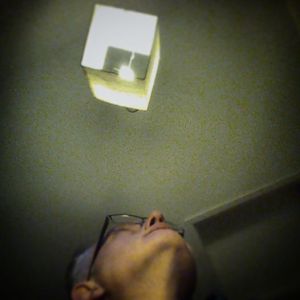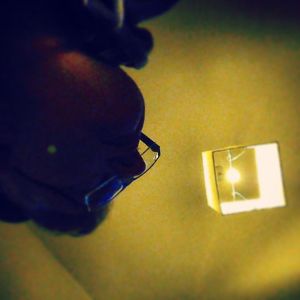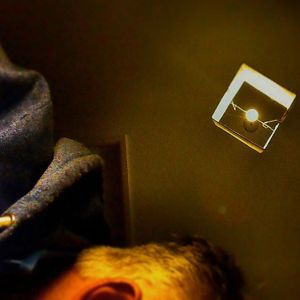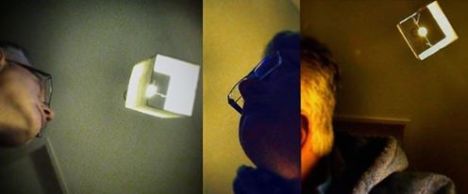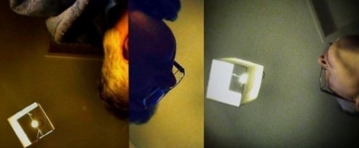Self-portraits are everywhere online and easily shared via mobile communication. The selfie is more than fashionable. It is an everyday practice of the state of personal publishing and ‘always on, everywhere’ networked media. The smartphone facilitates a personal push and pull media on a scale that we have never experienced before. Traditional film cameras were never widely used to photograph ourselves. We pointed the lens at our family and friends, learning to preserve ‘Kodak moments’ in physical frames and albums. The story behind this composite three-image photographic self-portrait is about the distractive state of everyday live, where moments of procrastination, rest or idleness are easily assigned to status updating, . This photograph is not just a self-portrait, it is an ‘us-portrait’, palm and finger akimbo, multiplied and montaged.
Of course that does not mean that the image is without a personal meaning or story, but it has general significance about the ‘mediated self’ at this media technological moment of ubiquitous cameraphones. There is an interesting, huge scale, rich media visualization project called Selfiecity that is studying the demographics, poses and expressions of the selfie and which claims that cities such as Bangkok, Berlin and Moscow each have their own style of taking selfies – that is, that cultural difference can be identified how we take selfies.
‘Looking At Yourself’? These days, in media terms, you hardly ever stop.
Anyway, this is how my selfie-portrait came about.
Working at home on a Winter Sunday afternoon in January 2015, with early disappearing light, and in need of distraction, I had an urge to Instagram. For some unknown reason, I placed the cameraphone on the floor and became aware of the electric light fitting on the ceiling and how from that angle it create an ‘L’ shape. On hands and knees I tried to put my head in the square frame because I thought that the light fitting and ceiling alone was too dull an image. Not wanting to look directly into the camera, the difficult bit was to look away from the screen and take the picture at the same time without knowing for sure about the framing – a trial and error process. I’m guessing that there were multiple attempts to get it ‘right’, to be aesthetically satisfied with the result. When taking an Instagram photo, I always scroll through the filter and settings options, but I don’t recall which ones I used for these images.
Instagram Selfie #1
Very soon after this first image, I must have decided that this was an interesting process and result, so two more images followed in the same way – but different framing of head and light and filters and settings.
Instagram Selfie #2
Instagram Selfie #3
I must have been struck by the outcome because I then shared the three images on Facebook and then combined the three images on my laptop to create one further composite image share on Facebook.
MeMeMe (Selfie-Portrait) (2015)
This self-portrait, then, was not done specifically for the ‘Looking At Yourself’ Visual Assignment, but, rather, the image chose the assignment. As I was deciding which visual assignment to do as part of Unit 5 ‘Telling Stories in Photos’ of open ds106, the whole experience seemed a perfect fit for the brief – ‘art following life’. Here was a self-portrait as a routine use of media in everyday life, an act of everyday creativity, not something done to order, or for professional or hobbyist reasons or to fulfill a creative assignment brief, but a spontaneous and routine thought and action if not specifically typical of what I do everyday, then a good general, though convoluted, example of habitual self-portraiture.
Starting with the three Instagrammed selfies:
I copied and pasted the images onto a blank slide in Microsoft PowerPoint. I like the rough and ready image manipulation and easy use of text and graphics that you can use in PowerPoint. When I’m not worrying too much about image resolution or more sophisticated techniques that might require more suitable software such as Photoshop, which is most of the time in a social media context, PowerPoint is perfectly adequate as a basic photo editor. Placing the three images initially side-by-side, I then rotated and resized them and overlapped them until I was happy with the composition. All the images were rotated to a different orientation than when they were originally captured on Instagram and the final composite image was saved using a screen capture utility (I use Gadwin PrintScreen to copy and paste and save as JPGs).
Having three light fittings in the composite image didn’t look properly balanced, so the middle image was placed to overlap the one on the left obliterating the light in the middle image. Most pleasing in terms of the composition was how the two images on the right could be combined so that a Cubist-like head and shoulders effect is created. On reflection, I also like that if the composite image of my head is taken as an ‘O’, then with the image turned upside down, you can perhaps make out a squiffy ‘LOL’ with the ‘L’s formed by the illuminated sides of the lightshade.
MeMeMeLOL
But this upsidedown ‘LOL’ version doesn’t work so well as a composition. During Unit 5 we were instructed to keep in mind at least three principles or ‘tips’ selected from study material provided to learn about taking good images. I decided to be guided by the ‘6 Principles of Gestalt Psychology That Can Improve Your Photography’ written about by photographer Joe Baraban. Looking at photography with these principles places an emphasis on the complete photograph as a relationship between its parts and the whole. The angle is to think about what the viewer percieves and processes visually and psychologically when looking at a photograph and therefore how a photogrpaher can control what the viewer sees.
Analysing my selfie-portrait using the ‘6 principles’, I can see how this applies. In terms of the ‘Figure-Ground’ principle, for example, where you are looking at the relationship between objects and their surroundings, the dull background of my composite photograph contrasts against the silhouette, and chiaroscuro of my head and body and the over-exposure of the light fitting. My selfie-portrait has ‘Closure’ through the visual tension of the repeated figure and light – puzzling, but not too so. ‘The Law of Common Fate’ principle is about visual direction in the image and with the placing of two of the figures looking at the same light source, this works in harmony. There is ‘Similarity’ with repetition of the figure and light and ‘Proximity’ of forms, shapes and colours. The dark palette, repetition of shapes and balanced grouping across the three images, two figures and lights, produces a balanced, off-centre effect, though not classically satisfying ‘Rule of Thirds’.
As an image, and a retrospectively conceptualised ‘selfie-portrait’, I’m more than happy with the image because it conveys a sense of myself as a creative person. Its origins lie in a serendipitous moment of distracted play, and I think that serendipity is one of the most important creative thinking techniques - ‘Chance favours the prepared mind’ (Louis Pasteur).


